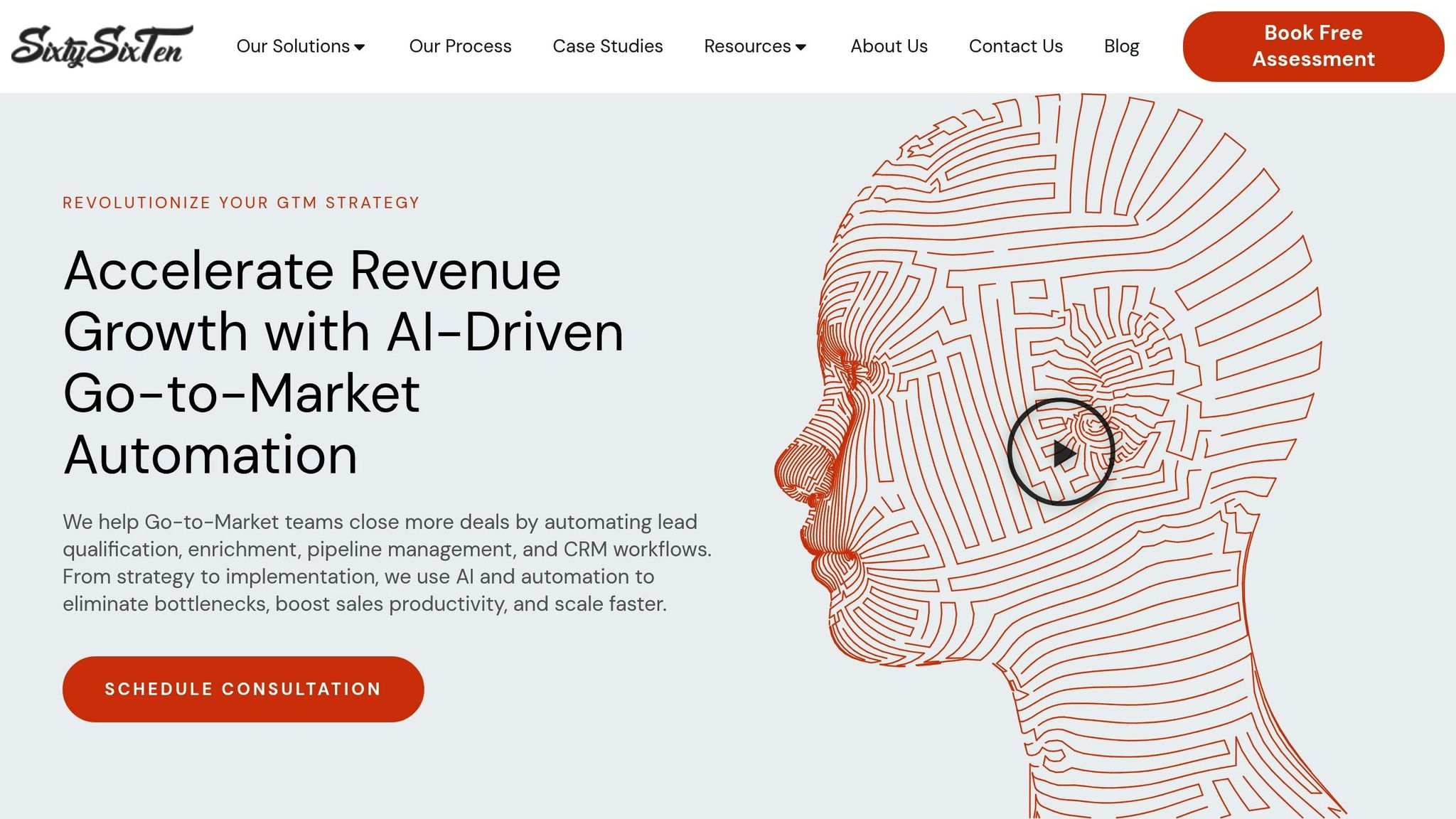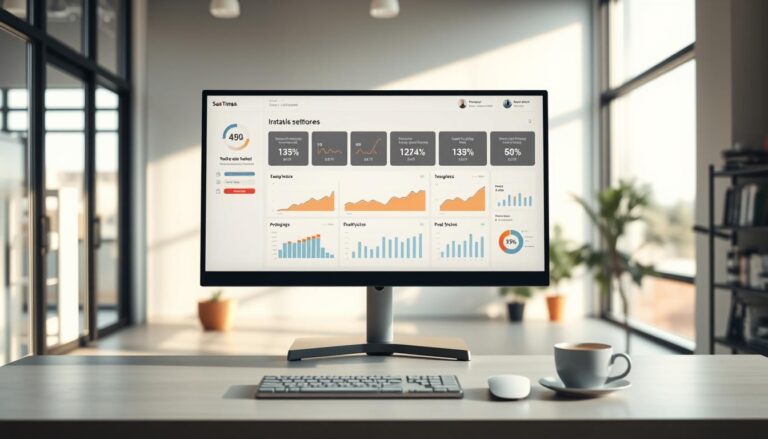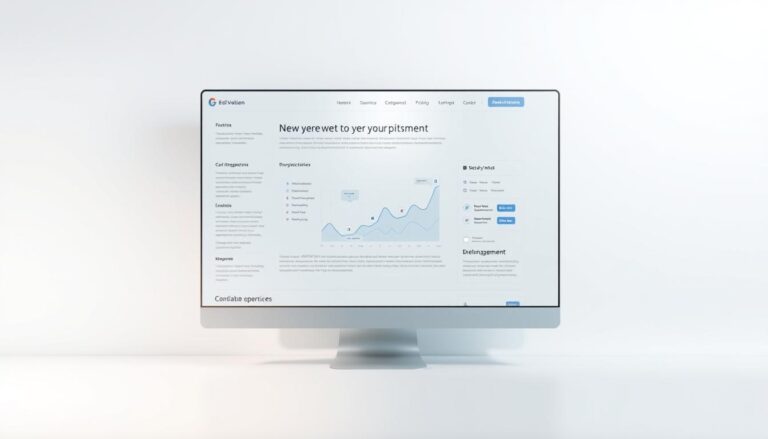AI-powered CRM tools are transforming sales forecasting by delivering precise, real-time insights, solving common challenges like messy data, human bias, and outdated information. Here’s how they make forecasting more reliable:
- Automated Data Cleaning: AI ensures clean, standardized data by fixing errors, filling gaps, and removing duplicates.
- Advanced Predictions: Machine learning analyzes thousands of data points like deal size, sales cycles, and customer behavior to predict outcomes with high accuracy.
- Real-Time Updates: Unlike manual methods, AI adjusts forecasts as deals progress, keeping revenue projections current.
- Risk Detection: AI identifies early warning signs in deals, such as low engagement or stalled progress, helping teams act quickly.
- Improved Efficiency: By automating repetitive tasks like lead scoring and data enrichment, sales teams can focus on closing high-value deals.
Companies using AI forecasting tools report better accuracy, faster decision-making, and increased revenue. The future of AI in CRM includes smarter predictions, real-time adaptations, and automated workflows, making it essential for businesses to stay competitive.
How Can I Integrate AI Sales Forecasting With My CRM System? – AI SaaS Software Explained
Problems with Manual Sales Forecasting
Before diving into the benefits of AI, it’s important to understand the challenges that come with manual sales forecasting. These traditional methods often fall short due to outdated processes and human limitations, making it tough to produce accurate revenue projections.
Data Entry and Quality Issues
One of the biggest hurdles is poor data quality. Sales reps frequently leave CRM fields incomplete or inconsistent. For instance, something as simple as slight variations in how a company’s name is entered can create duplicate records, throwing off analyses. On top of that, updates to the system are often delayed, further degrading the quality of the data.
When the foundation is flawed, the forecasts built on it are bound to be inaccurate.
Human Errors and Bias
Manual forecasting is also prone to human mistakes and subjective judgment. Sales reps might overestimate their chances of closing deals, leading to overly optimistic projections. On the flip side, individual interpretations of what qualifies as a strong lead can vary widely, introducing inconsistencies. These biases and errors chip away at the reliability of manual forecasts.
Outdated Information
Another major drawback is the lack of real-time data. Manual processes rely on periodic updates, which can leave teams blind to changes in deal statuses between reviews. This reliance on static, outdated reports makes it hard to react quickly to shifting market conditions or unexpected challenges. Without real-time insights, businesses are left playing catch-up.
These shortcomings make manual forecasting not only inefficient but also risky for decision-making. Recognizing these weaknesses sets the stage for understanding how AI can step in to deliver more accurate and dynamic solutions.
How AI Improves Sales Forecast Accuracy
Now that we’ve looked at the challenges of manual forecasting, let’s dive into how AI changes the game. AI-powered CRM systems tackle these issues by automating processes, identifying patterns, and delivering insights in real time – something human analysis simply can’t match. These capabilities directly address the errors and outdated data problems we discussed earlier.
Automated Data Collection and Cleaning
AI takes on data quality problems by automating how data is gathered and cleaned. It pulls in information from various sources, including email exchanges, website activity, social media interactions, and even third-party databases.
But AI doesn’t stop at collecting data – it also ensures the data is clean and standardized. It can spot duplicate entries, normalize company names, and even fill in missing details using enrichment processes. AI systems keep your CRM updated by detecting changes as they happen.
One standout feature is real-time data enrichment. This ensures your forecasts are based on the freshest and most accurate data, eliminating the guesswork associated with outdated records. With this reliable foundation, AI-driven machine learning models can generate far more precise forecasts.
Machine Learning Models for Better Predictions
Once the data is clean and enriched, machine learning takes over to deliver highly accurate forecasts. These models go beyond basic historical analysis, analyzing thousands of data points to uncover patterns humans might not notice. They consider everything from deal size and sales cycle length to prospect behavior, seasonal trends, and market conditions.
Machine learning models also adapt as they process new deals and respond to changing market conditions, continuously improving the accuracy of your forecasts. This adaptability ensures your system evolves alongside your sales environment.
OpenAI provides an excellent example of this in action. By implementing AI-driven workflows, the company dramatically improved its data enrichment coverage – from the low 40% range to over 80%. Scotty Huhn, who leads Revenue Strategy & Data at OpenAI, highlighted the impact:
"Clay enables our team to rapidly experiment with trigger driven workflows, and 3rd party enrichment data. We’re able to move fast and drive outsized impact on GTM execution – all while using a tool that’s fun, creative, and cutting edge."
Beyond improving predictions, these models also help sales teams manage risks proactively.
Early Risk Detection and Deal Scoring
AI helps spot potential risks early by analyzing intent signals, such as prospects changing jobs, website visit patterns, and engagement levels. These insights act as an early warning system, giving sales teams time to address problems before deals fall through.
AI also assigns probability scores to pipeline opportunities. These scores are based on historical data, engagement levels, and many other factors, offering an objective, data-driven alternative to subjective human assessments.
Anthropic saw measurable results after adopting AI-powered lead enrichment and scoring. Adam Wall, Head of Sales Operations at Anthropic, reported saving four hours per week by automating inbound lead enrichment and scoring in Salesforce. The system also tapped into over 100 data providers and automated all opportunity updates.
"Clay has helped Anthropic significantly improve our lead enrichment and sales data pipelines. We’ve been able to consolidate our tech stack to core essentials, like our CRM, Clay, and email tool."
With real-time scoring, enrichment, and segmentation, AI helps sales teams focus on high-intent buyer segments while flagging deals that need immediate attention. AI can even apply conditional logic, enriching only the most promising leads and creating fallback strategies to qualify others more effectively.
This holistic approach to analyzing deals and detecting risks lays the groundwork for forecasts that are not only highly accurate but also actionable, giving sales teams the tools they need to close more deals efficiently.
Measuring AI Forecasting Performance
After implementing AI-driven forecasting, it’s essential to monitor the right metrics to understand how well your system is performing. These metrics not only provide a clear view of your system’s accuracy but also highlight areas for improvement over time. Let’s dive into the key ways to measure AI forecasting performance.
Forecast Variance and Error Rates
One of the most straightforward ways to evaluate your AI forecasting is by looking at forecast variance and error rates. These metrics reveal how closely your predictions align with actual outcomes, offering a clear gauge of accuracy.
Mean Absolute Error (MAE) is a key metric for sales forecasting. It quantifies the average dollar difference between predicted and actual results. For example, if your forecast predicts $100,000 in revenue but you close at $95,000, the MAE would be $5,000.
Mean Absolute Percentage Error (MAPE) takes this a step further by expressing the error as a percentage. This makes it easier to compare performance across varying deal sizes or time periods. A MAPE of 10% indicates that your forecasts are typically within 10% of actual results.
AI systems excel at reducing these error rates over time. As machine learning models process more data and learn from past outcomes, their predictions become more precise, leading to better forecasting results.
Pipeline Health and Coverage Ratios
AI forecasting tools go beyond accuracy metrics – they also provide valuable insights into pipeline health and coverage ratios, which are critical for hitting sales targets.
The pipeline coverage ratio compares the value of your sales pipeline to your sales targets. A strong ratio, often 3:1 or 4:1, ensures you have enough opportunities to meet your goals. AI systems can calculate this ratio in real time and alert you if it dips below a healthy threshold.
Pipeline velocity measures how quickly deals progress through your sales funnel. AI can pinpoint bottlenecks and predict which deals might stall, allowing you to take action before it’s too late. When combined with deal scoring, this metric helps prioritize efforts on deals most likely to close.
Win rate by stage tracks how effectively your team converts opportunities at each step of the sales process. AI systems can analyze this metric across different segments, deal sizes, or time frames, uncovering trends that might otherwise go unnoticed. These insights help refine your strategy and improve overall performance.
Performance Benchmarks and Results
Real-world data shows that companies leveraging AI forecasting often achieve impressive results in both accuracy and efficiency.
For example, SixtySixTen’s AI and automation solutions have enabled clients to achieve a 30% increase in revenue while becoming 2.5x more efficient. Similarly, OpenAI’s implementation of AI-led research and enrichment capabilities led to a dramatic improvement in data quality, doubling their enrichment coverage from the low 40% range to over 80%. This improvement in data quality directly enhances forecast accuracy, as AI models can work with cleaner, more complete datasets.
Additionally, businesses using AI-powered lead scoring and enrichment report significant time savings alongside better accuracy. By automating data entry and analysis, sales teams can focus on high-probability deals, improving productivity and closing rates.
The most successful AI implementations track multiple dimensions of performance – not just forecast accuracy, but also pipeline health, data quality, and team efficiency. This holistic approach ensures that AI forecasting delivers measurable value across your entire sales operation, setting the stage for sustained growth and continuous improvement. These metrics validate AI’s impact and lay the groundwork for refining strategies moving forward.
sbb-itb-647c22e
Implementing AI Forecasting with SixtySixTen

Implementing AI forecasting can feel like navigating a maze of technical challenges and business goals. That’s where SixtySixTen steps in. They specialize in improving forecast accuracy and streamlining operations for post-PMF B2B SaaS companies.
SixtySixTen’s GTM Automation Approach
SixtySixTen works exclusively with post-PMF B2B SaaS companies – businesses that have already nailed their product-market fit but are grappling with the complexities of scaling their go-to-market strategies. Their approach combines technical know-how with a deep understanding of business needs, delivering AI-driven forecasting solutions that hold up in practical, day-to-day use.
The process kicks off with a thorough review of your current forecasting workflow. They pinpoint bottlenecks causing inefficiencies or inaccuracies, then design tailored automation systems. These systems use AI to dynamically adjust lead scoring, enrichment, and segmentation based on patterns in your historical data.
AI Tools and CRM Workflows
SixtySixTen uses a mix of no-code/low-code platforms and custom development to cater to a variety of needs. Their toolkit includes platforms like n8n, Zapier, Make.com, Clay.com, Trigify, Google Looker, and PowerBI, along with custom-built AI agents.
"We build using tools like Clay, n8n, and custom AI agents, integrating directly with your existing CRM, sales tools, and outbound platforms."
Clay plays a key role in their workflows. With access to data from over 150 providers, it enables processes like identifying new leads, scoring accounts, personalizing outreach, and acting on intent signals (e.g., job changes or website visits). Its AI-powered research tools uncover unique data points and create context-aware agents that continuously feed clean, formatted data into your CRM. This ensures your forecasting models always work with the most accurate and up-to-date information. Beyond that, SixtySixTen helps automate top-of-funnel tasks, CRM updates, and outreach workflows, making everything run more smoothly.
This integration doesn’t stop there – it extends into unified reporting, ensuring your sales metrics always reflect the latest performance data.
Unified Dashboards and Real-Time Reporting
SixtySixTen builds unified dashboards that deliver real-time insights into go-to-market performance. By eliminating the delays often tied to manual forecasting, their real-time reporting keeps teams on the same page with consistent performance updates. If off-the-shelf tools fall short of your reporting needs, their engineering team can develop custom solutions to track critical metrics. This unified reporting system ensures that sales, marketing, and leadership teams are all working from a single, reliable source of truth.
Best Practices for AI-Driven Forecasting Success
Nailing AI forecasting isn’t just about having cutting-edge technology – it’s about creating the right environment for that technology to thrive. The difference between AI systems that deliver exceptional results and those that fall short often boils down to how well you implement these core practices. These steps ensure your data, models, and team work seamlessly together, setting the stage for reliable AI forecasting.
Maintain Clean CRM Data
Your AI forecasting system is only as reliable as the data it learns from. The accuracy of your predictions directly depends on the quality of your data. Clean, consistent data acts as the foundation for dependable AI-driven insights.
To achieve this, establish clear data quality standards across your organization. Define what a complete record looks like, set rules for how information should be entered into your system, and implement validation processes to catch errors before they cause problems. For example, ensure deal stages use consistent naming conventions, contact details are fully completed, and opportunity values follow standardized formats.
Schedule regular audits – monthly, if possible – to catch duplicates, incomplete records, and outdated entries. Identify recurring errors in your data fields and adjust your system’s rules or training to address these issues.
Automation tools like those offered by SixtySixTen can be a game-changer. These tools help flag inconsistencies, fill in missing data, and standardize formats, reducing the manual workload while ensuring your AI models always have high-quality inputs.
Align AI Models with Sales Processes
AI tools work best when they’re tailored to your specific business needs. The most successful implementations align AI systems with your existing sales processes rather than forcing your team to adapt to the technology. This alignment ensures predictions are more accurate and actionable.
Start by mapping out your sales workflow in detail. Document how leads move through your pipeline, what triggers stage changes, and which data points your team relies on for forecasting decisions. This detailed understanding acts as a blueprint for configuring your AI system to complement your workflows instead of disrupting them.
Focus on automating repetitive tasks that don’t add value, like lead qualification, data enrichment, pipeline updates, or CRM management. By taking these tasks off your team’s plate, AI allows them to focus on what they do best: building relationships and closing deals. When your team sees AI simplifying their work rather than complicating it, resistance to adoption often fades.
Context-aware AI makes a huge difference. Build systems that can tap into your company’s unique data sources – whether it’s Salesforce records, Gong call transcripts, or internal documents. This ensures the predictions and insights are tailored to your specific business scenarios, not just general market trends.
Build Team Adoption and Trust
Even the best AI systems will fall short if your team doesn’t trust or adopt them. Building trust starts with showing clear value and positioning AI as a tool that enhances their work, not as a threat to their jobs.
Start by identifying tasks that AI can handle more efficiently than humans – like data entry, lead scoring, or generating reports. Track measurable improvements, such as time saved, reduced manual effort, or increased forecast accuracy, and share these results with your team regularly. When they see tangible benefits, they’re more likely to embrace the technology.
Show your team how AI insights can help them prioritize high-value prospects, identify deals that need attention, and make better use of their time. Offer hands-on training during the rollout, provide easy-to-follow guides, and be available to answer questions. A smoother learning curve leads to quicker adoption.
Allow your team to personalize the system to fit their workflows. Platforms that support visual customization and experimentation make it easier for employees to adapt the tools to their working style, increasing consistency in usage.
Trust doesn’t happen overnight – it builds through consistent, accurate results. Start with low-stakes predictions and gradually expand AI’s role as your team gains confidence in its reliability. The goal is to create a partnership where human expertise and AI insights work together to achieve outcomes neither could accomplish alone.
The Future of AI in Sales Forecasting
AI is transforming how businesses approach revenue planning and growth strategies. As these tools become more advanced, the divide between companies that leverage AI and those sticking to traditional methods will grow even larger.
For SaaS companies, the potential benefits of AI in sales forecasting are only beginning to unfold.
Benefits for SaaS Companies
SaaS businesses generate vast amounts of data, and AI uses this information to predict customer behavior, identify churn risks, and uncover opportunities for growth.
Revenue forecasting becomes far more precise with AI. By analyzing diverse data points – like customer usage patterns, support ticket trends, feature adoption, and engagement metrics – AI provides forecasts that go beyond guesswork or basic pipeline calculations. This depth of insight empowers leadership to make smarter decisions about hiring, product development, and market expansion.
AI also takes the heavy lifting out of forecasting. It automates complex tasks, enabling teams to focus on building customer relationships and scaling operations without sacrificing accuracy.
As deal volumes increase, AI handles the added complexity effortlessly, maintaining reliable predictions regardless of how much data it processes. For B2B SaaS companies that have achieved product-market fit, AI becomes a long-term advantage. The more data these systems analyze, the sharper their predictions get, creating a self-improving loop that drives better outcomes over time.
And this is just the beginning – AI in CRM is poised for even greater advancements.
What’s Next for AI and CRM
The future of AI in CRM and forecasting will focus on delivering context-aware insights and predictive recommendations. These systems won’t just highlight potential outcomes; they’ll suggest actionable steps and even automate routine tasks based on forecasted scenarios.
Conversational AI interfaces are set to make forecasting tools more accessible. Instead of navigating through complicated dashboards, sales managers will be able to ask questions in plain English – like, “What’s our projected revenue for next quarter?” – and get detailed answers, complete with visuals. This approach will make data insights more user-friendly, speeding up decision-making across all levels of the organization.
Another exciting development is real-time adaptation. While current AI models rely heavily on historical data, future systems will adjust forecasts on the fly as market conditions shift. Whether it’s an economic downturn, a competitor’s new product launch, or a sudden industry trend, these platforms will recalibrate instantly to ensure predictions stay accurate, even in unpredictable situations.
AI will also improve through the integration of external data sources. By pulling in information like social media sentiment, economic trends, industry reports, and competitive intelligence, these systems will offer a more complete view of market dynamics. This holistic approach will help businesses anticipate changes and adapt their strategies before those shifts impact their sales pipelines.
Finally, automated workflow orchestration will bridge the gap between insights and action. For example, if AI identifies a deal at risk, it could automatically trigger follow-up emails, schedule meetings, or notify the right team members to intervene. This seamless connection between forecasting and execution will maximize the impact of AI-driven insights, making them even more valuable for businesses.
For companies looking to stay ahead, adopting AI isn’t just an option – it’s a necessity. The sooner these tools are implemented, the better positioned businesses will be to thrive in an increasingly competitive landscape.
FAQs
How does AI make sales forecasts more accurate than traditional methods?
AI-driven CRM systems take sales forecasting to the next level by automating the analysis of massive datasets, spotting patterns, and minimizing the likelihood of human error. Unlike traditional manual approaches, AI works faster and with greater consistency, giving businesses the ability to make smarter, data-backed predictions.
SixtySixTen uses AI and automation to refine sales workflows and simplify processes. This approach not only boosts the precision of forecasts but also supports businesses in scaling operations effectively and achieving long-term growth.
What are the main advantages of using AI-powered CRM tools for sales teams?
AI-powered CRM tools bring a host of benefits to sales teams by simplifying daily tasks and boosting productivity. They take over tedious activities like qualifying leads, updating CRM systems, and managing follow-ups, giving sales professionals more time to concentrate on closing deals.
These tools also improve precision and allow for a more tailored approach with features like real-time lead scoring, data enrichment, and segmentation. By speeding up tasks such as scheduling demos and managing pipelines, AI-powered CRMs enable sales teams to operate more efficiently and deliver stronger outcomes.
How can businesses evaluate the success of their AI-powered sales forecasting systems?
To measure how well AI-powered sales forecasting systems are performing, businesses can focus on critical metrics like forecast accuracy, revenue growth, and sales cycle efficiency. By connecting AI tools with CRM platforms, companies can streamline data collection and analysis, making it simpler to uncover insights that drive decisions.
Another important aspect to monitor is how effectively the system minimizes manual errors, refines lead scoring, and supports better decision-making across the board. Consistently reviewing these results helps ensure the AI system stays aligned with sales objectives and delivers real, measurable benefits.



